No matter how many books one reads, it is always a pleasant surprise to come across books that introduce you to new things and change how you think. Such books must be cherished, marked, talked about, and read repeatedly.
The Art of Creative Thinking was a surprise for me. Not only because it was more than what I expected, but because it's the kind of book that I generally wouldn't go for. I always thought I disliked such books. But then, a process of changing is liking new things and finding the value in what we didn't value before.
about The Art of Creative Thinking
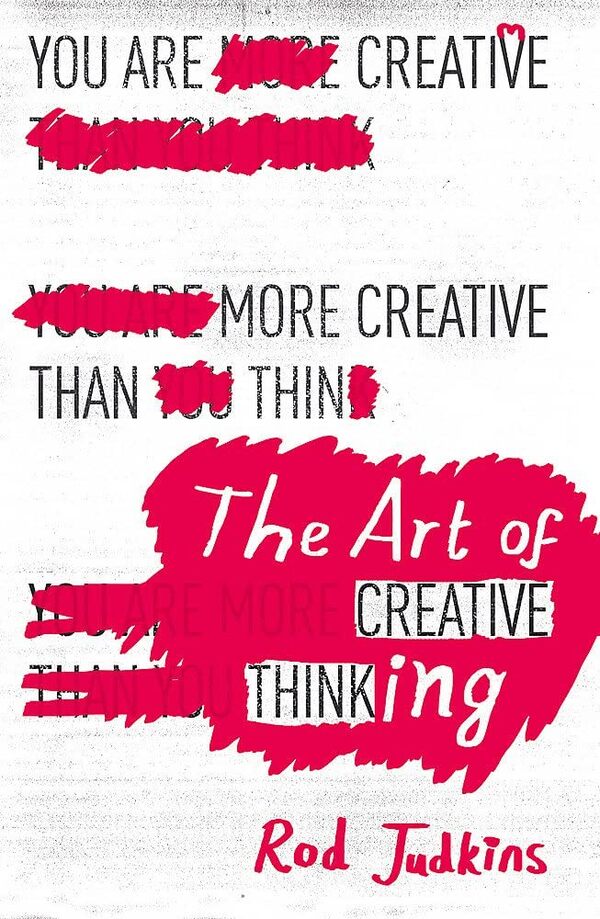
THE ART OF CREATIVE THINKING reveals how we can transform our businesses, our society and ourselves through a deeper understanding of human creativity. Rod Judkins, a lecturer in creativity at the world-famous St Martin's College of Art, will examine the behaviour of successful creative thinkers and explain how all of us can learn from them to improve our lives. Judkins will draw on an extraordinary range of reference points, from the Dada Manifesto to Andy Warhol's studio, via Steve Jobs, Nobel Prize winning economists and many others, and distil a lifetime's expertise into 90 succinct chapters. Along the way he shares the story of most successful class in educational history (in which every single student won a Nobel prize); shows why graphic nudity during public speaking can be both a curse and surprisingly persuasive; and reveals why, in the twenty-first century, it's technically illegal to be as good as good as Michelangelo.
my review & more
Firstly, this isn't a self-help book. The title gives that impression and it is usually shelved as self-help but it is not. While it does provide advice and how-tos, it doesn't work like the usual self-help books. It is not a comprehensive guide to improve your creativity, it is not a sectioned and orderly book, and it definitely isn't a book that gives you a ton of actionable items.
The Art of Creative Thinking is not a regular novel. If you go into it expecting it to be like other novels, you will be sorely disappointed. It is not a linear book and it does not connect related chapters in the traditional way, even if the content relates. Chapter 12 may relate to chapter 76 and there can be no indication of it. The author may repeat a point in completely different chapters which have different contexts. Two consecutive chapters will be totally disjointed. There isn't a rhythm or a flow.
The book is meant to be read randomly. The author says so himself in the introduction (and more often than not, it is a good idea to read the way the author suggests). Reading it like any other book is a disservice to the book and yourself because you won't get what it is actually trying to say.
This book is not meant to be read in a linear way. When your creativity is running low or you feel the need for inspiration, open it at any page at random.
A reviewer on Goodreads said that "You might as well just browse an inspiration Pinterest board" and I agree with the comparison, not with the point. It takes time to browse Pinterest and put together a board that can inspire you in 5 minutes if you ever need it. That work is done for you in this book.
Rod Judkins has written 90 concise anecdotal chapters about creativity. It is a bunch of anecdotes about successful and/or popular creative people and what they did. It is like a bunch of articles or quick blog posts compiled in one book. It is lowkey like a Pinterest board, ready to give you quick doses of inspiration but nothing deep.
The book is literally "this creative method worked for this person, you should try it too." It does not say why that creative is good, it doesn't talk about how that advice helps or the mechanics behind it, and it doesn't give a guide on how to do it. It never goes deep into any of the topics. It doesn't talk about how the brain works or how some things unlock creativity in the brain. And the main thing is: it doesn't guarantee anything.
Sometimes you succeed and sometimes you fail but it's important to try everything and see what happens.
The author puts forward some information and it is up to the reader to do what they want with it. You can take the topic and research it, read longer biographies of the people mentioned, or you can put the idea into action and see if it works for you. You can pick apart what the author says and fill your thoughts in between the lines or you can write a blog post on why the author is wrong.
While there are totally almost 300 pages, each chapter is 2-5 pages. Each chapter takes only around 5 minutes to read so that you can quickly get some ideas or inspiration that can kickstart your creativity and move on. So yes, it is like an inspirational Pinterest board, only that it is in written form and is not in technology. You are more likely to get distracted when Pinterest is your go-to but you won't with this paperback. And that's the thing, the book does everything to make sure it doesn't distract you and lead you on random tangents.
The point is not to read the book and learn, it's to do something with what it's saying. That's why there isn't anything deep and there isn't any explanation or reasoning behind what is said. That's why two consecutive chapters are not related and one chapter doesn't flow into the next. All of those things will keep you reading the book and won't let you go to do what you should be doing—which is getting creative.
Creativity is like mining; we need to dig deep to discover and uncover ourselves.
I know, I'm putting a big emphasis on how to read the book and what to expect from it. That's because I recognize how one can easily miss the value the book gives by expecting something else. I went through a lot of the negative reviews on Goodreads and most of them didn't like the book because they were expecting something from the book which it does not give. It's important to keep an open mind.
The only reason I did not fall into the same trap was because I have been trying to pick up random books with an open mind. I went to the bookstore and was browsing all the random books. I found this and flipped through a few pages. That little bit of pre-reading helped me understand what the book is like and how I should approach it.
I took the author's advice and read the book randomly. Every morning or whenever I had some free time, I would read a chapter or two and go on with my day. Sometimes, the words stayed with me throughout the day. Sometimes, I totally forgot about them. A few times, the book inspired me to come up with ideas or create content. And one time, it gave me a new lens to look at my job with.
Since the first few chapters I read were wonderful, I expected to love everything about the book. But I found chapters that I didn't like, I disagreed with the author multiple times, and I criticized what was said more than I expected to. Only later did I realize that the book isn't written for one person. You may like some chapters and hate others. You may disagree with the chapter that I found the most inspirational.
You're supposed to take what you want from the book. The idea is to try most of what it suggests at least once and then keep what works for you, discarding the rest.
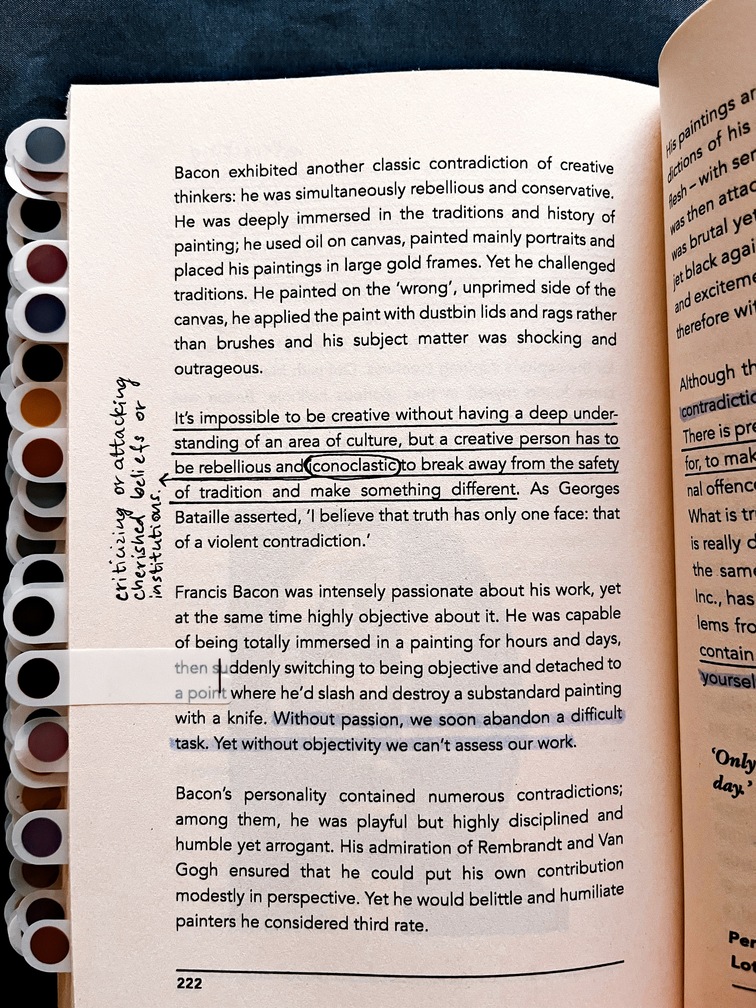
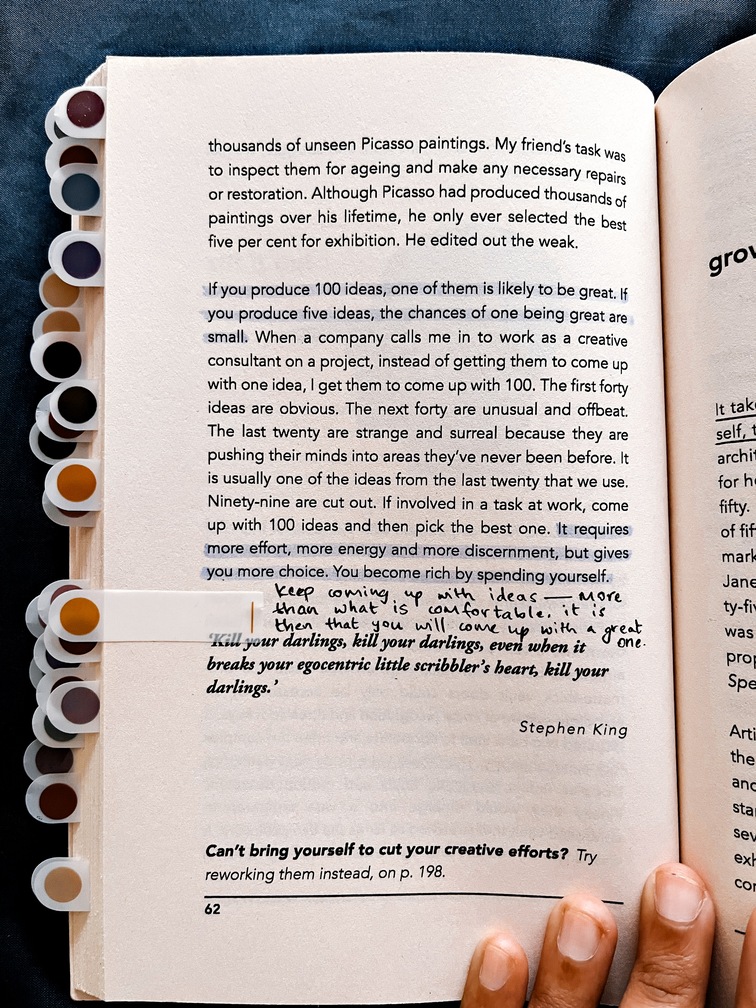
I had the most fun annotating the book. Each chapter is supposed to be read in 5 minutes and to get you doing something, but I often didn't have the time to do anything and I also had a lot of thoughts about what was being said. I wrote a lot of thoughts, commentary, and ideas in the margins. I connected what was said in the chapters to the Kdramas I was watching or other books that I read.
It took over two months for me to read every chapter in the book, especially since I was reading randomly and didn't know where unread chapters were. Even now, I'm not sure if I fully covered the book. There may be some chapters that I skipped over by mistake that I will discover in the future.
It was interesting to see the parallels between what this book said and what creative people unconsciously follow. It was fun to notice the similarities between great artists that are known worldwide and people I follow on the internet who are relatively undiscovered.
Even though the chapters were very small—sometimes only a page and a half—they had a lot of value. The author gives the bare minimum to push the reader to be creative, but there's actually a lot of reasoning behind each point. Whenever I realized it, I annotated my thoughts and tabbed the pages.
I started annotating with a specific scheme in mind but it quickly deteriorated into vibes. Since it took over two months, I couldn't remember or stick to the scheme. By the end, the only thing that stayed true was my golden tabs which marked actionable points. The browns and greens are "discussion points" and "interesting things" and whatever else.
From the amount of brown and green tabs I used, it is clearly seen that I found a lot of the points discussion-worthy. I really liked that almost every chapter gave me something to think about and something that I can create content on. I've already written two newsletters related to things in the book and I'm looking forward to writing more.
I'm also looking forward to adding more annotations over time and eventually owning a book so different from what I bought because my interwoven thoughts will make it something else. This is a book that I will reach for when I need quick doses of ideas or inspiration and I will own it (probably) forever.
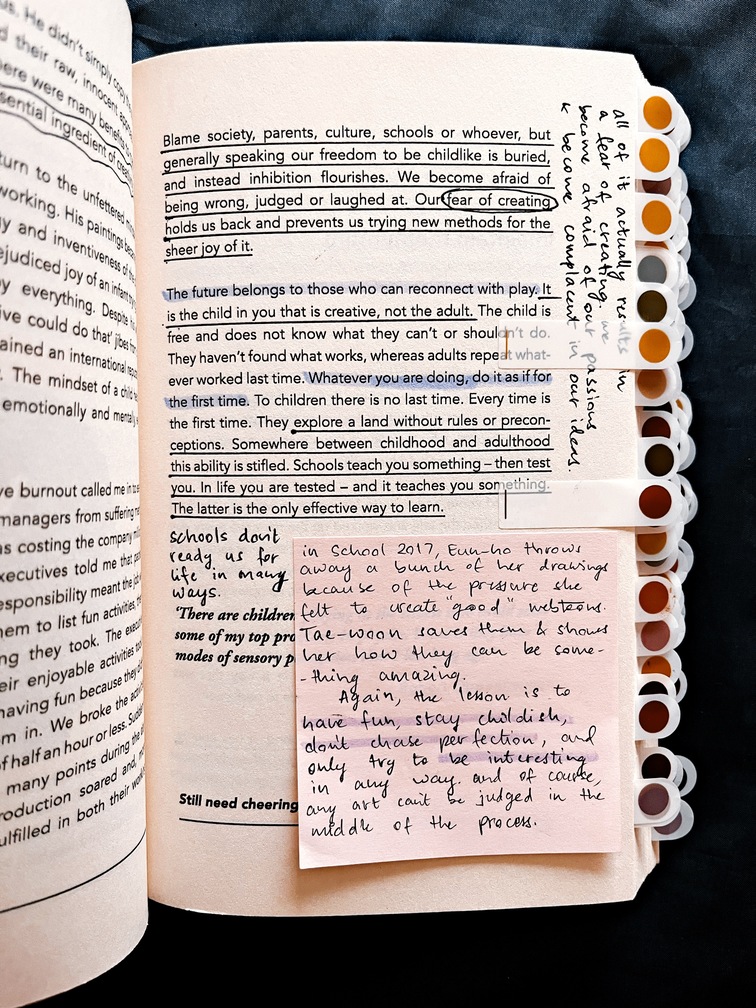
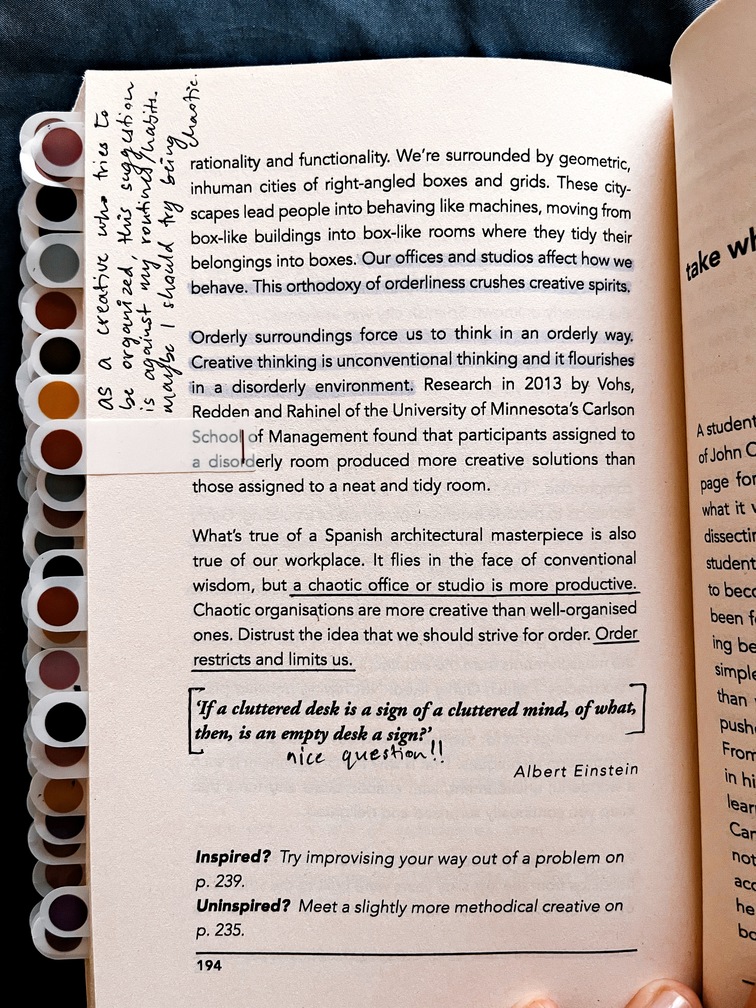
I also really liked how the book encourages change and contradiction. It doesn't expect the reader to agree with all of what it says. In fact, it has several contradictory chapters.
I said before that consecutive chapters are usually not linked but chapters away from each other can be. Some of those links are subtly mentioned in the book.
At the bottom of the last page of every chapter, there is a link to another chapter(s). These links can take you several pages ahead or to the beginning of the book. But they aren't always direct relations. They can mention the same point in a different context or say a contradictory point.
I really liked how these links were subtle and encouraged non-linear reading. I could put down the book whenever I wanted, go in my own direction, or follow the links if they sounded interesting.
It was interesting how, often, similar chapters were not linked at all and very different chapters would be linked because they have one thread in common. I made several of my own connections while reading the chapters and often flipped through the book to find what I read earlier. It was like making a web of my own and it was fun.
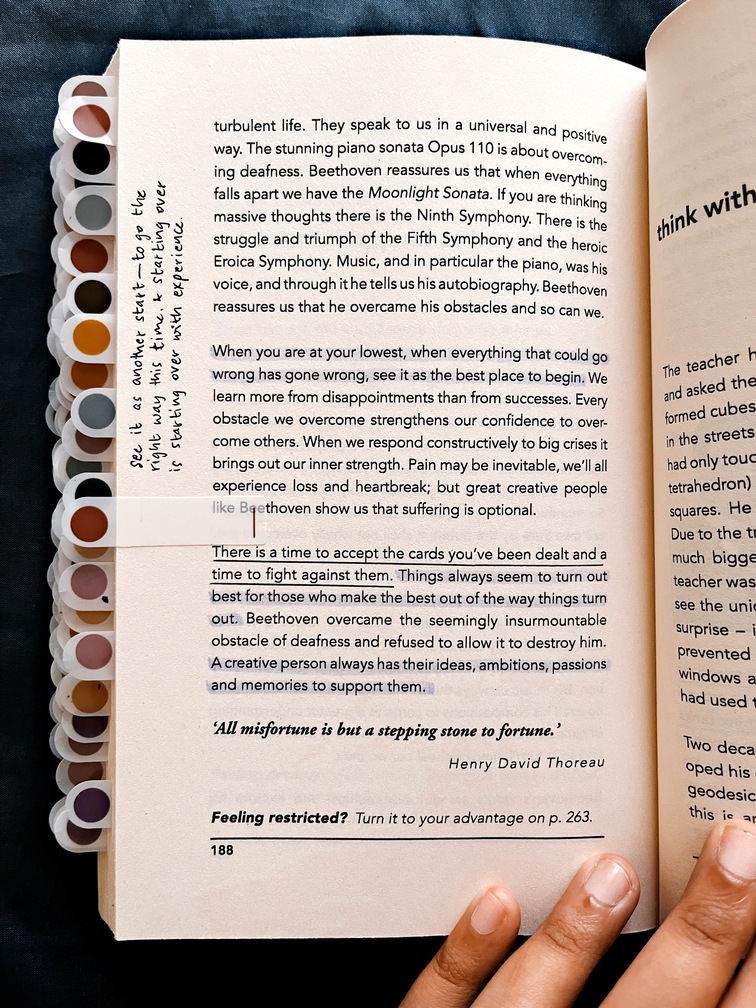
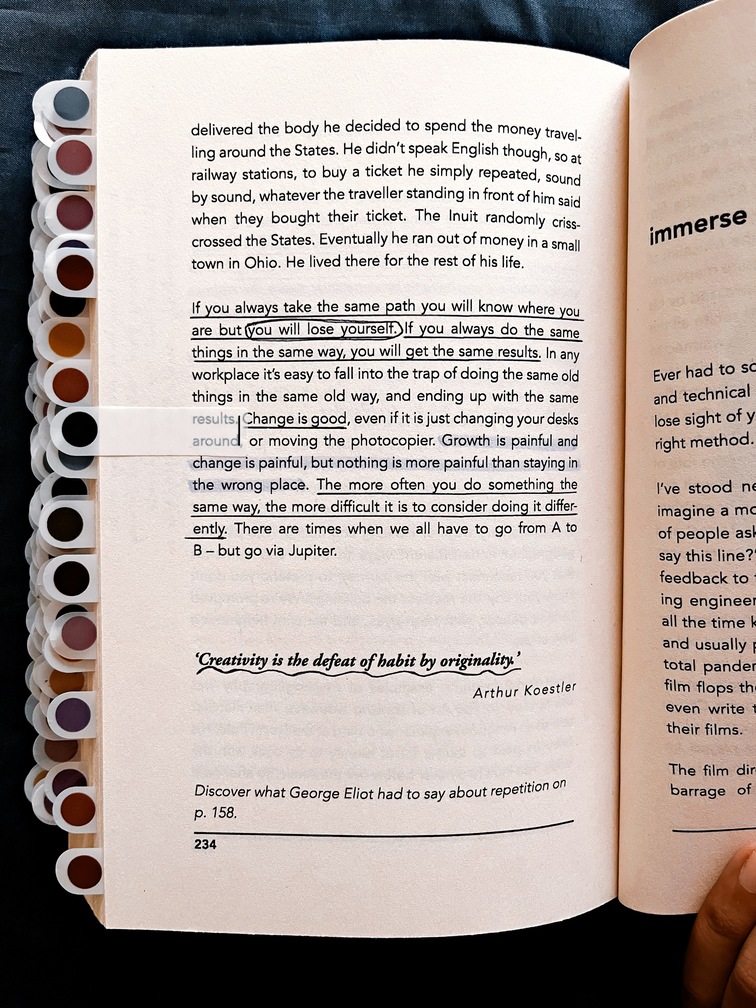
Although I really enjoyed the book, I have a few criticisms as well.
Each chapter is written to be concise and just put across a point. But often, the point isn't put across well. In some chapters, the author simply shares the anecdotes and the reader has to figure out what's being suggested. The writing felt clumsy and awkward at times.
It felt like there wasn't much editing done to fix each chapter. At least within a chapter, there needs to be a flow but that was often missing. The author jumped between points and didn't say what they wanted to well. Hence, some chapters were annoying to read.
Another fault of the writing was that there were too many anecdotes and not enough direction or actionable sentences. A couple of chapters were only anecdotes with nothing else. While I like knowing examples to make sense of the context, examples aren't enough to say everything. There were too many stories about other people and not enough about what to learn from them.
That leads to another point: there wasn't enough actionable advice. Only a few chapters in the entire book gave the reader directions on what they can do or try. All the other chapters simply mentioned what other people did. Some of the advice gets lost here because some examples are of people doing totally wild things in wilder contexts and we need help to apply those ideas in our lives.
The chapters could have been rewritten with better structure and flow, with lesser anecdotes and more actionable suggestions.
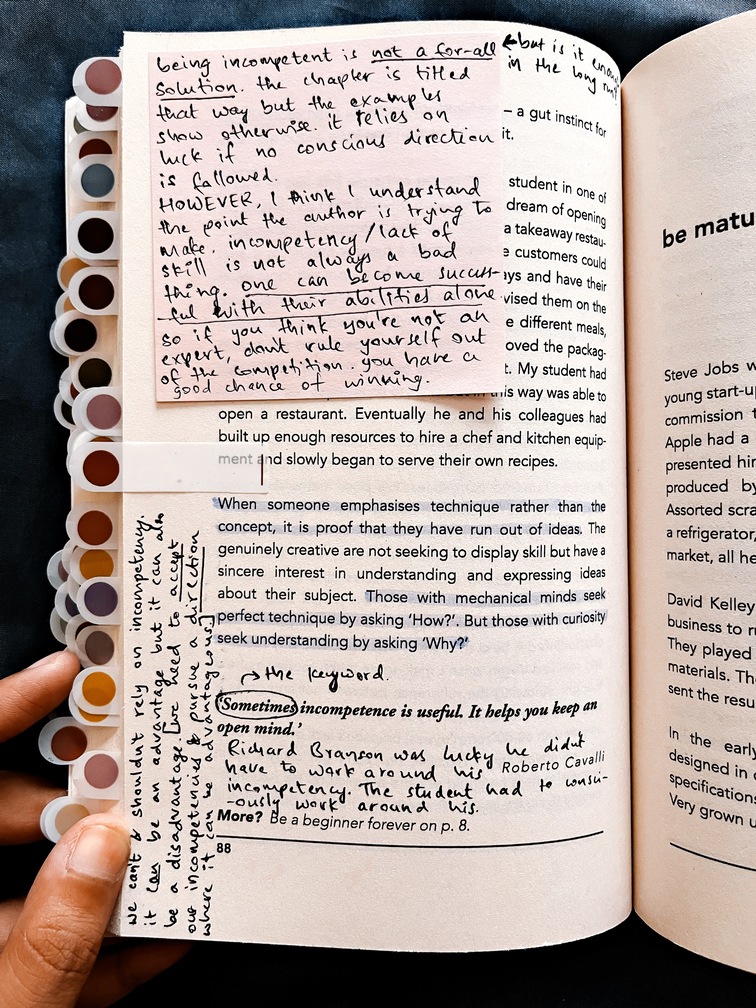
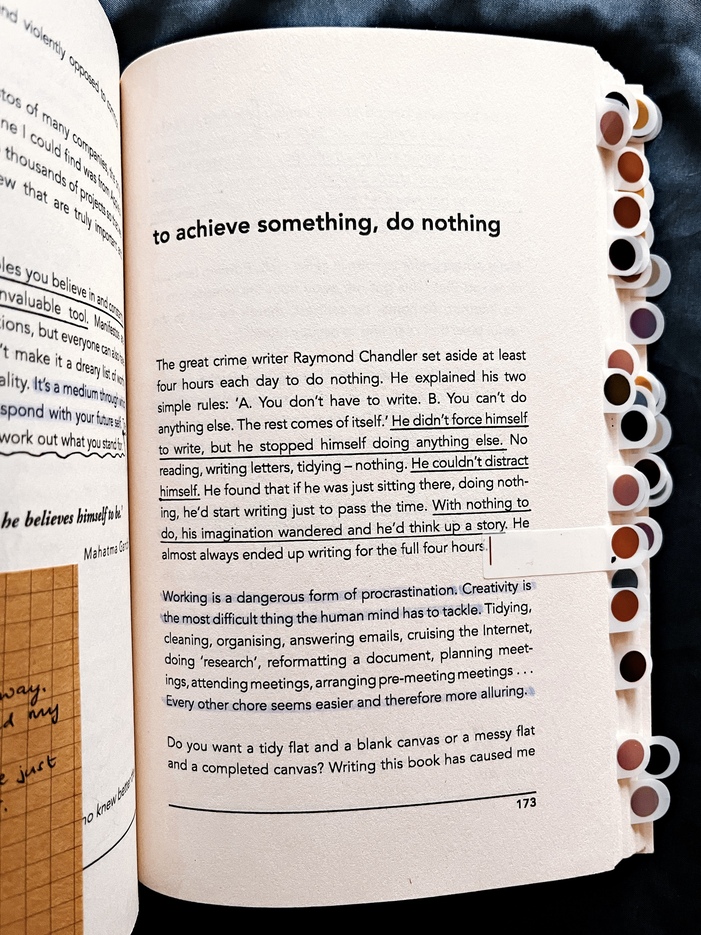
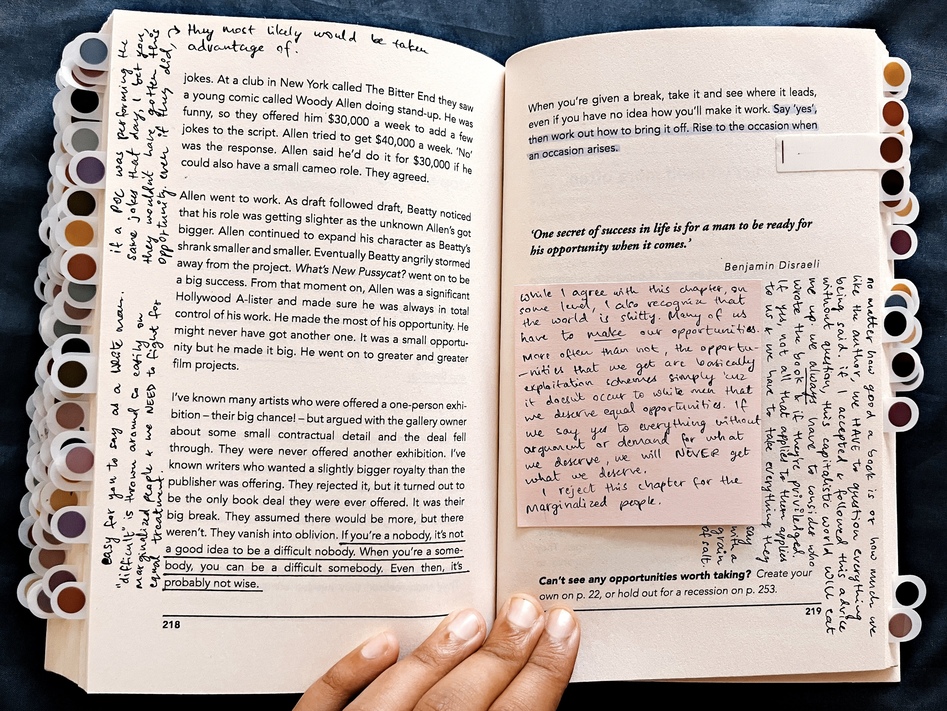
The biggest complaint I have is with the anecdotes chosen. The book mentioned at least 100 people—but none of them were people of colour. I understand that the author wanted to pick the most well-known people to drive the points home, and historically people who "succeeded" were generally Caucasian, but there are a handful of people of colour who could have been mentioned.
Books like these are a problem because there isn't any effort made to include people of colour who have been the backbone of important developments and instead choose to mention White people who are even somewhat known. It was especially annoying because there were some people mentioned that I have never heard of, but they were clearly from the same group.
It's a little insulting and demotivating when the people whose success stories are mentioned are the ones born with a silver spoon. If one can ignore the privilege of the people mentioned and how it gave them an invisible leg up, the book is motivating and inspiring. But once you start finding out more about them and if you're not in that group, the book isn't so nice.
And speaking of privilege, many of the tips and ideas mentioned are ones you can't follow unless you're privileged to do so. There were chapters that said to blow off meetings, quit your job, take a long time off, only focus on your craft and nothing else, change your schedule completely, etc. Such things aren't possible unless one has no responsibilities and money to live on without working a full-time job. Some chapters actually assumed that one has all day(s) to apply what's suggested.
overall
The Art of Creative Thinking isn't a perfect or groundbreaking book. It is simply a collection of ideas put across in an interesting way. While there are some glaring flaws, I do plan on keeping this book on my shelf for years to come. Its aim is to provide inspiration, so I'm keeping it to get quick doses of that whenever I'm in a slump.
I wouldn't recommend it to everyone but I would suggest flipping through a few pages if you can. It might just be the book for you. Your enjoyment of the book totally depends on how you read it and what you expect from it.
Delve into books, magazines, documentaries, your culture, your heroes, and your mentors, because these are the gateways to creative opportunities.
discuss with me!
Have you read any books on creativity? I have been looking for such books (next on my list is Creative Confidence), so if you have any recommendations, do give them to me in the comments!
What do you think about books like The Art of Creative Thinking—books with anecdotes and small chapters instead of a proper novel? Would you rather follow a blog or get your info through the internet now that we have that option?

I love your annotations! I'm not the biggest fan of self-help books, and I am very selective with the ones I do read. This one sounds amazing though, especially if you work in an industry that demands creativity every day. Some days you have to dig deeper than others.
I have previously read this book, and I agree with everything you have said. Since I primarily work to find creative ideas to communicate difficult investing concepts and products these days, I have read a few similar ones that open up more perspectives about thinking creatively.
"Damn Good Advice" by George Lois was written by one of the highest-paid copywriters/art directors in the world, who unfortunately passed away a few months ago. It doesn't provide actionable advice like a Twitter thread, but its 120 chapters offer great insight into how he thinks and operates. The entire book can be read in one hour because each chapter consists of just one image and one paragraph showcasing his unabashed chutzpah.
"The Copy Book - How Some of the Best Advertising Writers in the World Write Their Advertising" by Taschen features 53 leading advertising creative directors from around the world. Each of them gets a page or two where the authors allow them to share their thoughts and work, followed by the best works they have published (mostly ads).
"Ogilvy on Advertising" may already be familiar to you, but it personally taught me how creativity and its applicability have changed over the years. This book was considered a bible by many copywriters a few decades ago, but people's tastes and attention spans have since evolved. For example, Ogilvy suggested that writing in black font on a white background is the best approach and discouraged people from doing the opposite. However, today many successful brands like CRED and Uber use the opposite style. If you enjoy reading well-written long copy ads, you would love this book.
"Hey Whipple, Squeeze This" by Luke Sullivan is one of the finest books available that provides detailed action plans on how to write in a captivating manner. Although the book begins by discussing ad spaces in the US in the 1950s, which might not be relatable to everyone, I recommend watching the ads that he talks about simultaneously on YouTube to further immerse yourself in the book. The author has been in the ad agency business for a long time. While I unconsciously felt a lot of the things he speaks about, I never deeply pondered on those topics or perspectives because i felt they are evident. However, listening to someone bring them up for discussion made me think deeper, and I could relate a lot, feeling very validated.
Unfortunately, all the above books are quite expensive. I have physical copies of all them except for the last one, which was gifted to me in Kindle format by a fund manager at my firm. If you'd like to browse through them or borrow them to read, feel free to let me know, and I'll bring them.
This sounds really amazing and from all that annotation pics only I could say you really enjoyed this. Non-fictions are hit or miss for me so I might have to try this. Fabulous review!
Do give it a flip through at least!